2005 BMW 645CI CONVERTIBLE wheel size
[x] Cancel search: wheel sizePage 169 of 217
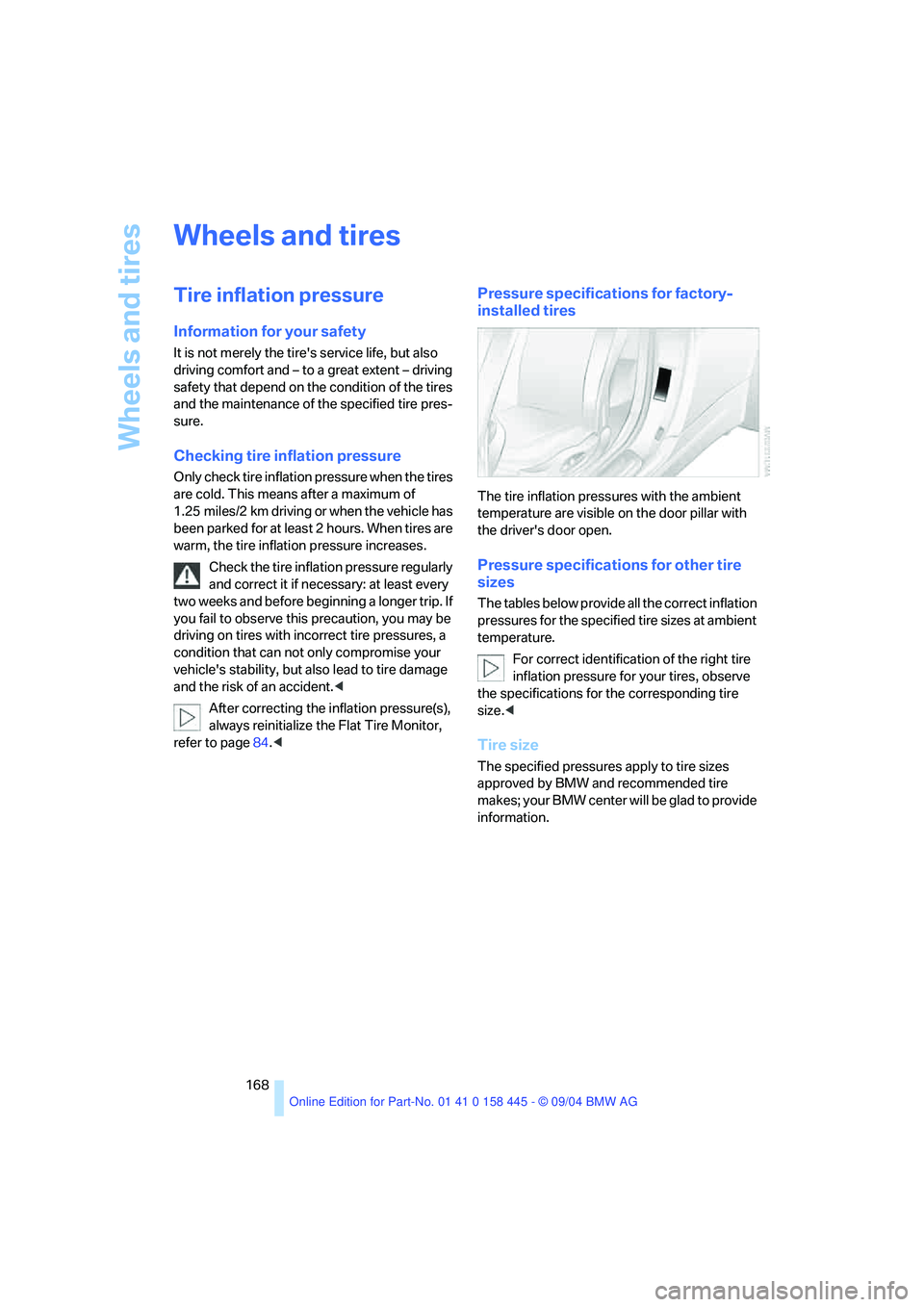
Wheels and tires
168
Wheels and tires
Tire inflation pressure
Information for your safety
It is not merely the tire's service life, but also
driving comfort and – to a great extent – driving
safety that depend on the condition of the tires
and the maintenance of the specified tire pres-
sure.
Checking tire inflation pressure
Only check tire inflation pressure when the tires
are cold. This means after a maximum of
1.25 miles/2 km driving or when the vehicle has
been parked for at least 2 hours. When tires are
warm, the tire inflation pressure increases.
Check the tire inflation pressure regularly
and correct it if necessary: at least every
two weeks and before beginning a longer trip. If
you fail to observe this precaution, you may be
driving on tires with incorrect tire pressures, a
condition that can not only compromise your
vehicle's stability, but also lead to tire damage
and the risk of an accident.<
After correcting the inflation pressure(s),
always reinitialize the Flat Tire Monitor,
refer to page84.<
Pressure specifications for factory-
installed tires
The tire inflation pressures with the ambient
temperature are visible on the door pillar with
the driver's door open.
Pressure specifications for other tire
sizes
The tables below provide all the correct inflation
pressures for the specified tire sizes at ambient
temperature.
For correct identification of the right tire
inflation pressure for your tires, observe
the specifications for the corresponding tire
size.<
Tire size
The specified pressures apply to tire sizes
approved by BMW and recommended tire
m a k e s ; y o u r B M W c en t e r w i ll b e g l a d t o p ro v id e
information.
Page 171 of 217
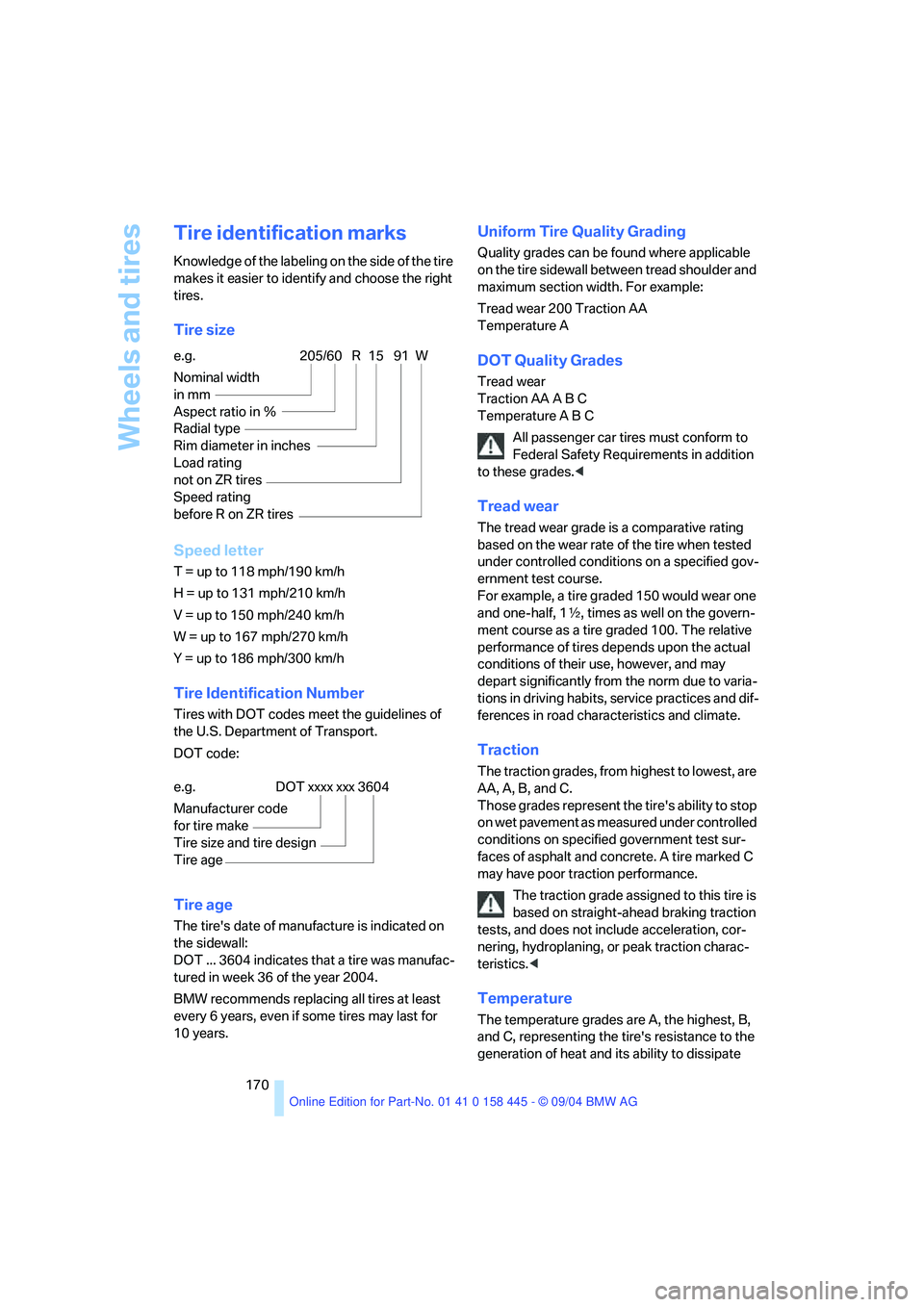
Wheels and tires
170
Tire identification marks
Knowledge of the labeling on the side of the tire
makes it easier to identify and choose the right
tires.
Tire size
Speed letter
T = up to 118 mph/190 km/h
H = up to 131 mph/210 km/h
V = up to 150 mph/240 km/h
W = up to 167 mph/270 km/h
Y = up to 186 mph/300 km/h
Tire Identification Number
Tires with DOT codes meet the guidelines of
the U.S. Department of Transport.
DOT code:
Tire age
The tire's date of manufacture is indicated on
the sidewall:
DOT ... 3604 indicates that a tire was manufac-
tured in week 36 of the year 2004.
BMW recommends replacing all tires at least
every 6 years, even if some tires may last for
10 years.
Uniform Tire Quality Grading
Quality grades can be found where applicable
on the tire sidewall between tread shoulder and
maximum section width. For example:
Tread wear 200 Traction AA
Temperature A
DOT Quality Grades
Tread wear
Traction AA A B C
Temperature A B C
All passenger car tires must conform to
Federal Safety Requirements in addition
to these grades.<
Tread wear
The tread wear grade is a comparative rating
based on the wear rate of the tire when tested
under controlled conditions on a specified gov-
ernment test course.
For example, a tire graded 150 would wear one
and one-half, 1γ, times as well on the govern-
ment course as a tire graded 100. The relative
performance of tires depends upon the actual
conditions of their use, however, and may
depart significantly from the norm due to varia-
tions in driving habits, service practices and dif-
ferences in road characteristics and climate.
Traction
The traction grades, from highest to lowest, are
AA, A, B, and C.
Those grades represent the tire's ability to stop
on wet pavement as measured under controlled
conditions on specified government test sur-
faces of asphalt and concrete. A tire marked C
may have poor traction performance.
The traction grade assigned to this tire is
based on straight-ahead braking traction
tests, and does not include acceleration, cor-
nering, hydroplaning, or peak traction charac-
teristics.<
Temperature
The temperature grades are A, the highest, B,
and C, representing the tire's resistance to the
generation of heat and its ability to dissipate e.g.
Nominal width
in mm
Aspect ratio in Ξ
Radial type
Rim diameter in inches
Load rating
not on ZR tires
Speed rating
before R on ZR tires
205/60 R 15 91 W
e.g.
Manufacturer code
for tire make
Tire size and tire design
Tire ageDOT xxxx xxx 3604
Page 173 of 217
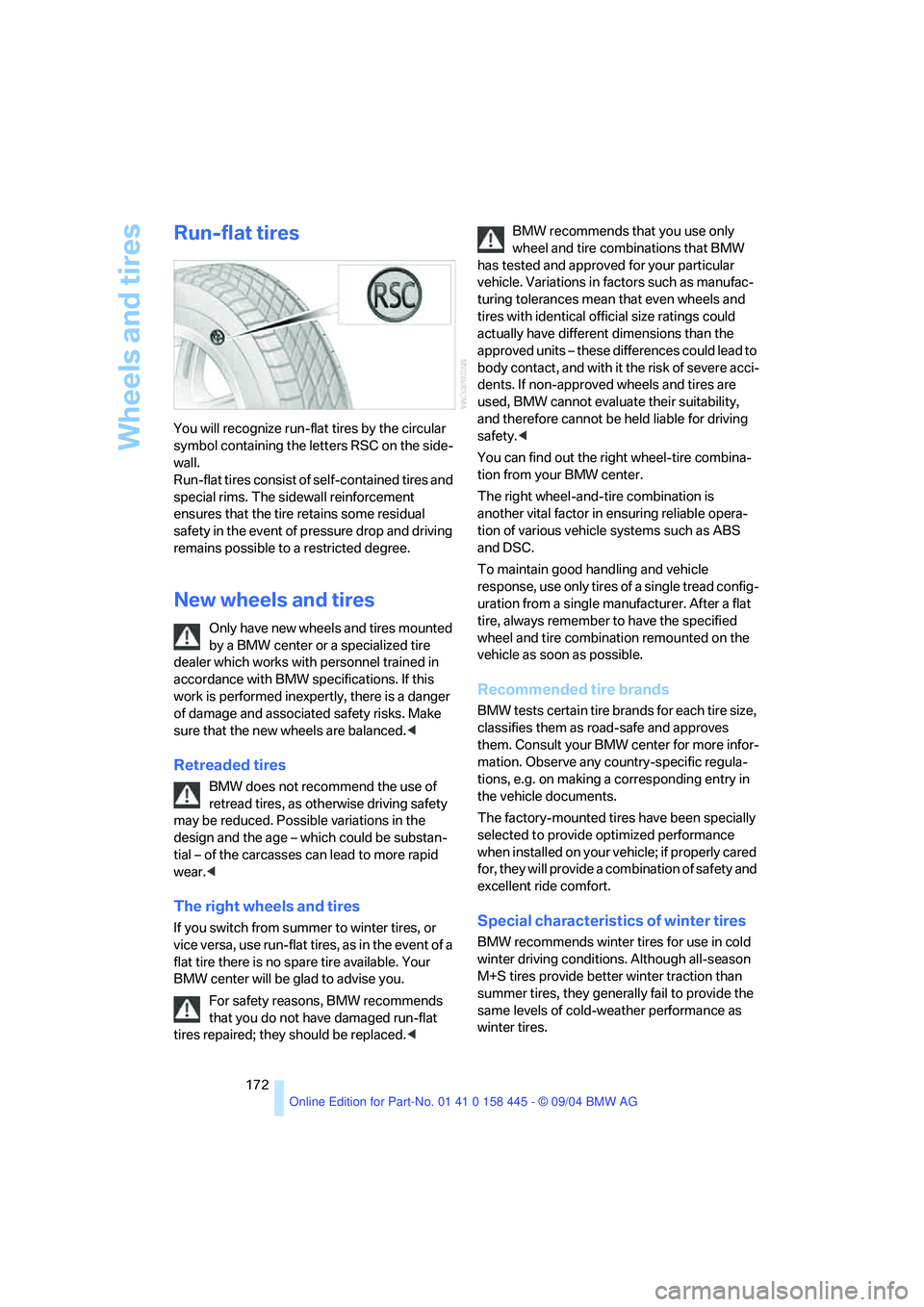
Wheels and tires
172
Run-flat tires
You will recognize run-flat tires by the circular
symbol containing the letters RSC on the side-
wall.
Run-flat tires consist of self-contained tires and
special rims. The sidewall reinforcement
ensures that the tire retains some residual
safety in the event of pressure drop and driving
remains possible to a restricted degree.
New wheels and tires
Only have new wheels and tires mounted
by a BMW center or a specialized tire
dealer which works with personnel trained in
accordance with BMW specifications. If this
work is performed inexpertly, there is a danger
of damage and associated safety risks. Make
sure that the new wheels are balanced.<
Retreaded tires
BMW does not recommend the use of
retread tires, as otherwise driving safety
may be reduced. Possible variations in the
design and the age – which could be substan-
tial – of the carcasses can lead to more rapid
wear.<
The right wheels and tires
If you switch from summer to winter tires, or
vice versa, use run-flat tires, as in the event of a
flat tire there is no spare tire available. Your
BMW center will be glad to advise you.
For safety reasons, BMW recommends
that you do not have damaged run-flat
tires repaired; they should be replaced.
has tested and approved for your particular
vehicle. Variations in factors such as manufac-
turing tolerances mean that even wheels and
tires with identical official size ratings could
actually have different dimensions than the
approved units – these differences could lead to
body contact, and with it the risk of severe acci-
dents. If non-approved wheels and tires are
used, BMW cannot evaluate their suitability,
and therefore cannot be held liable for driving
safety.<
You can find out the right wheel-tire combina-
tion from your BMW center.
The right wheel-and-tire combination is
another vital factor in ensuring reliable opera-
tion of various vehicle systems such as ABS
and DSC.
To maintain good handling and vehicle
response, use only tires of a single tread config-
uration from a single manufacturer. After a flat
tire, always remember to have the specified
wheel and tire combination remounted on the
vehicle as soon as possible.
Recommended tire brands
BMW tests certain tire brands for each tire size,
classifies them as road-safe and approves
them. Consult your BMW center for more infor-
mation. Observe any country-specific regula-
tions, e.g. on making a corresponding entry in
the vehicle documents.
The factory-mounted tires have been specially
selected to provide optimized performance
when installed on your vehicle; if properly cared
for, they will provide a combination of safety and
excellent ride comfort.
Special characteristics of winter tires
BMW recommends winter tires for use in cold
winter driving conditions. Although all-season
M+S tires provide better winter traction than
summer tires, they generally fail to provide the
same levels of cold-weather performance as
winter tires.
Page 174 of 217
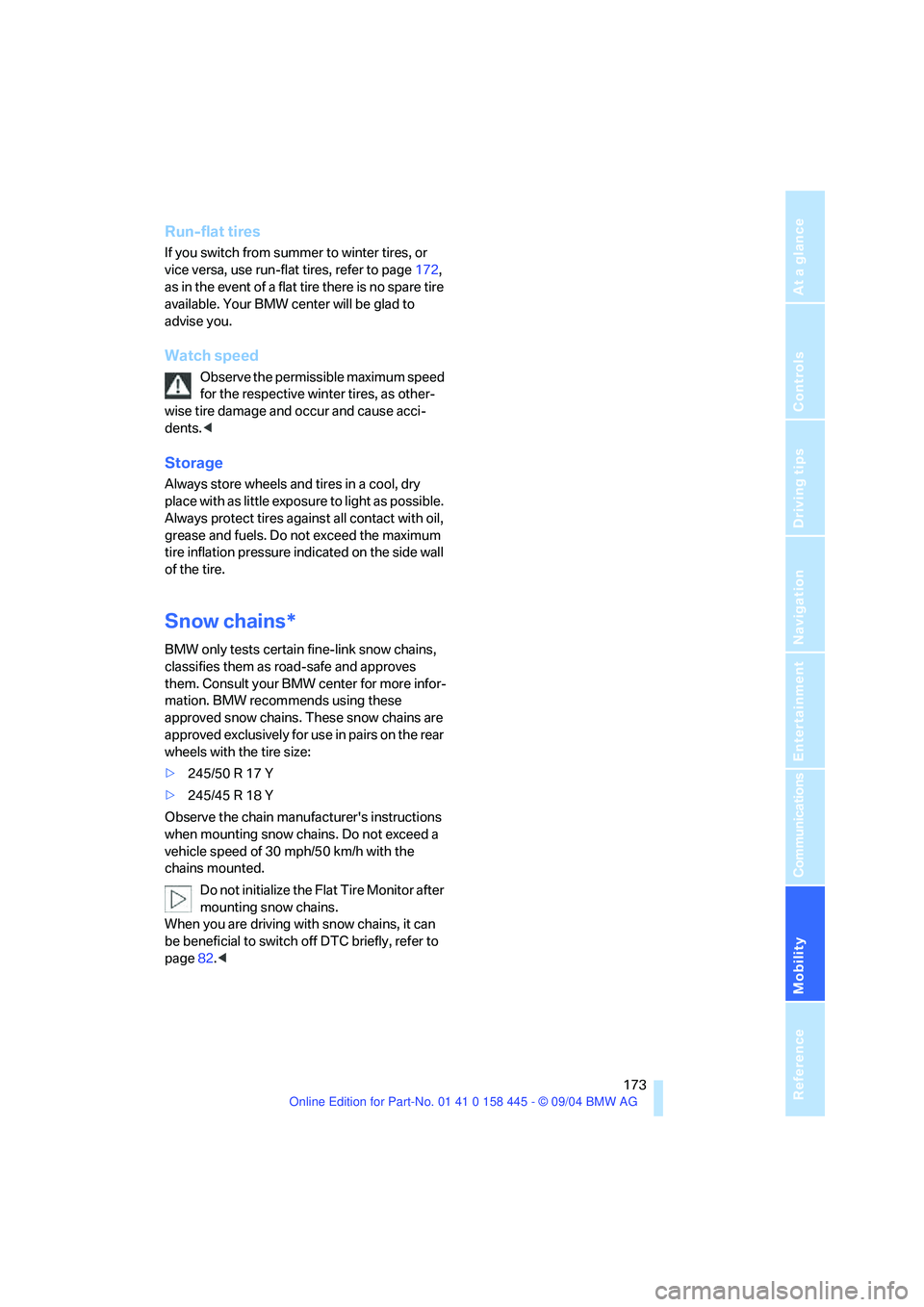
Mobility
173Reference
At a glance
Controls
Driving tips
Communications
Navigation
Entertainment
Run-flat tires
If you switch from summer to winter tires, or
vice versa, use run-flat tires, refer to page172,
as in the event of a flat tire there is no spare tire
available. Your BMW center will be glad to
advise you.
Watch speed
Observe the permissible maximum speed
for the respective winter tires, as other-
wise tire damage and occur and cause acci-
dents.<
Storage
Always store wheels and tires in a cool, dry
place with as little exposure to light as possible.
Always protect tires against all contact with oil,
grease and fuels. Do not exceed the maximum
tire inflation pressure indicated on the side wall
of the tire.
Snow chains*
BMW only tests certain fine-link snow chains,
classifies them as road-safe and approves
them. Consult your BMW center for more infor-
mation. BMW recommends using these
approved snow chains. These snow chains are
approved exclusively for use in pairs on the rear
wheels with the tire size:
>245/50 R 17 Y
>245/45 R 18 Y
Observe the chain manufacturer's instructions
when mounting snow chains. Do not exceed a
vehicle speed of 30 mph/50 km/h with the
chains mounted.
Do not initialize the Flat Tire Monitor after
mounting snow chains.
When you are driving with snow chains, it can
be beneficial to switch off DTC briefly, refer to
page82.<
Page 213 of 217
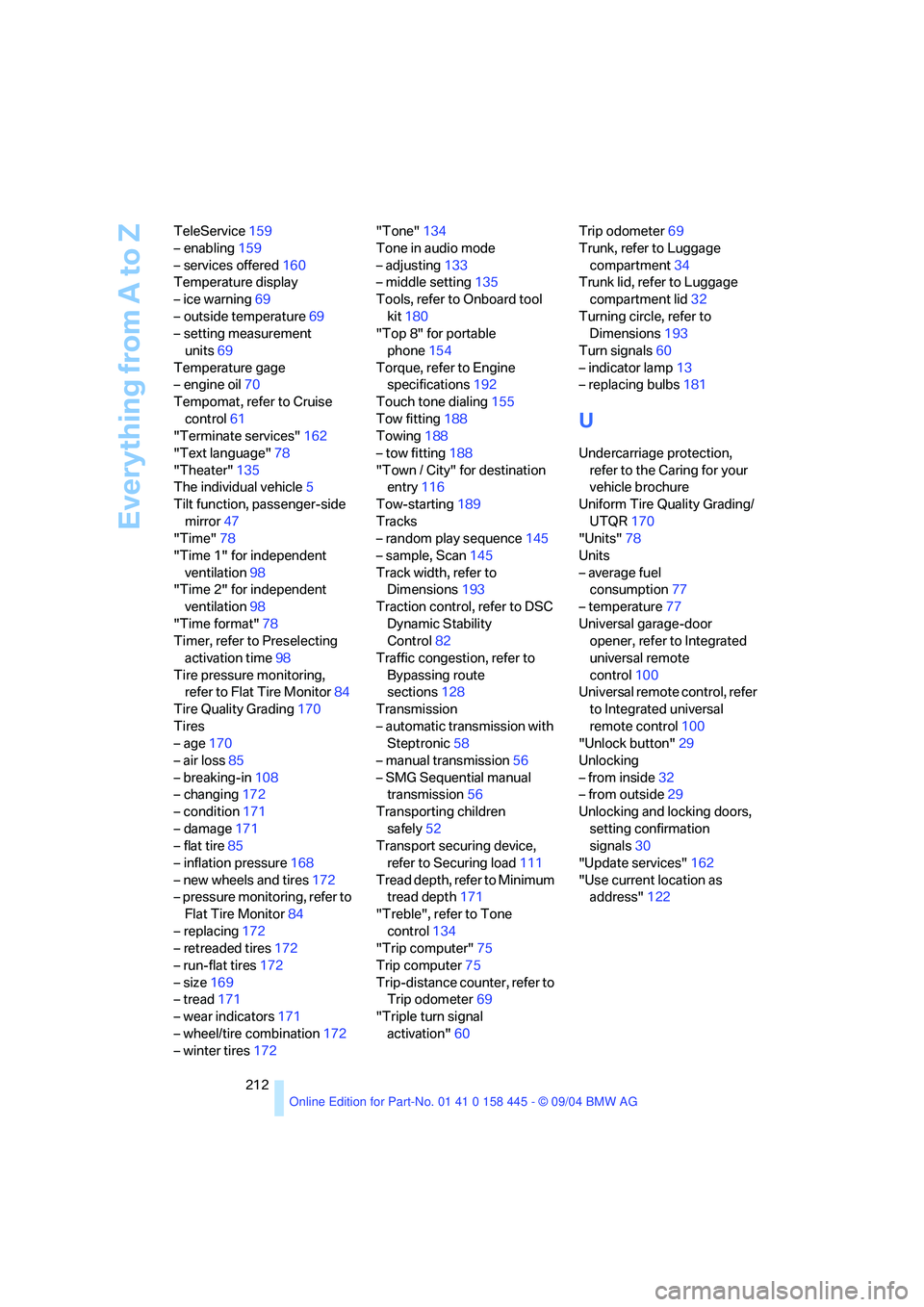
Everything from A to Z
212 TeleService159
– enabling159
– services offered160
Temperature display
– ice warning69
– outside temperature69
– setting measurement
units69
Temperature gage
– engine oil70
Tempomat, refer to Cruise
control61
"Terminate services"162
"Text language"78
"Theater"135
The individual vehicle5
Tilt function, passenger-side
mirror47
"Time"78
"Time 1" for independent
ventilation98
"Time 2" for independent
ventilation98
"Time format"78
Timer, refer to Preselecting
activation time98
Tire pressure monitoring,
refer to Flat Tire Monitor84
Tire Quality Grading170
Tires
– age170
– air loss85
– breaking-in108
– changing172
– condition171
– damage171
– flat tire85
– inflation pressure168
– new wheels and tires172
– pressure monitoring, refer to
Flat Tire Monitor84
– replacing172
– retreaded tires172
– run-flat tires172
– size169
– tread171
– wear indicators171
– wheel/tire combination172
– winter tires172"Tone"134
Tone in audio mode
– adjusting133
– middle setting135
Tools, refer to Onboard tool
kit180
"Top 8" for portable
phone154
Torque, refer to Engine
specifications192
Touch tone dialing155
Tow fitting188
Towing188
– tow fitting188
"Town / City" for destination
entry116
Tow-starting189
Tracks
– random play sequence145
– sample, Scan145
Track width, refer to
Dimensions193
Traction control, refer to DSC
Dynamic Stability
Control82
Traffic congestion, refer to
Bypassing route
sections128
Transmission
– automatic transmission with
Steptronic58
– manual transmission56
– SMG Sequential manual
transmission56
Transporting children
safely52
Transport securing device,
refer to Securing load111
Tread depth, refer to Minimum
tread depth171
"Treble", refer to Tone
control134
"Trip computer"75
Trip computer75
Trip-distance counter, refer to
Trip odometer69
"Triple turn signal
activation"60Trip odometer69
Trunk, refer to Luggage
compartment34
Trunk lid, refer to Luggage
compartment lid32
Turning circle, refer to
Dimensions193
Turn signals60
– indicator lamp13
– replacing bulbs181
U
Undercarriage protection,
refer to the Caring for your
vehicle brochure
Uniform Tire Quality Grading/
UTQR170
"Units"78
Units
– average fuel
consumption77
– temperature77
Universal garage-door
opener, refer to Integrated
universal remote
control100
Universal remote control, refer
to Integrated universal
remote control100
"Unlock button"29
Unlocking
– from inside32
– from outside29
Unlocking and locking doors,
setting confirmation
signals30
"Update services"162
"Use current location as
address"122